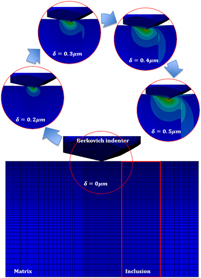Crossref Citations
This article has been cited by the following publications. This list is generated based on data provided by
Crossref.
Liu, Jiahan
Zeng, Qiang
and
Xu, Shilang
2020.
Is scratch test proper to characterize microstructure and mechanical properties of cement-based materials? The effects of loading level and routine.
Cement and Concrete Research,
Vol. 133,
Issue. ,
p.
106072.
Arevalo, Sofia E.
and
Pruitt, Lisa A.
2020.
Nanomechanical analysis of medical grade PEEK and carbon fiber-reinforced PEEK composites.
Journal of the Mechanical Behavior of Biomedical Materials,
Vol. 111,
Issue. ,
p.
104008.
Bakhti, Hamzah
Weyrich, Thomas
Es-Souni, Martha
Laghrissi, Ayoub
and
Es-Souni, Mohammed
2021.
Non-fouling polymer films on hard-anodized aluminum substrates: Nanomechanical properties and modelling.
Progress in Organic Coatings,
Vol. 161,
Issue. ,
p.
106553.
Tran, H.S.
Bouffioux, C.
Dedry, O.
Rojas-Ulloa, C.
Duchêne, L.
Mertens, A.
and
Habraken, A.M.
2022.
Identification of a soft matrix-hard inclusion material by indentation.
International Journal of Mechanical Sciences,
Vol. 235,
Issue. ,
p.
107723.
Patel, Hinal R.
Flood, Shannon H.
Raju, Hermise
Tenorio, Max C.
and
Pelegri, Assimina A.
2022.
Nanoindentation of freestanding single Kevlar® fibers with an adjusted indentation area function.
Journal of Materials Research and Technology,
Vol. 19,
Issue. ,
p.
1472.
Dash, R
Bhattacharyya, K
Kumar, R P
and
Bhattacharyya, A S
2022.
Intensified chipping during nanoindentation and the effect of friction on the interfacial fracture for thin films used in N/MEMS.
Engineering Research Express,
Vol. 4,
Issue. 4,
p.
045012.
Gonabadi, H.
Oila, A.
Yadav, A.
and
Bull, S.
2022.
Investigation of the Effects of Environmental Fatigue on the Mechanical Properties of GFRP Composite Constituents Using Nanoindentation.
Experimental Mechanics,
Vol. 62,
Issue. 4,
p.
585.
Sadyrin, Evgeniy V.
Nikolaev, Andrey L.
Bardakova, Regina A.
Kotova, Anzhelika A.
Kharchevnikov, Ivan O.
Zabiyaka, Igor Yu.
and
Aizikovich, Sergei M.
2023.
Deformation and Destruction of Materials and Structures Under Quasi-static and Impulse Loading.
Vol. 186,
Issue. ,
p.
245.
Ding, Yue
Liang, Xuan-Ming
Li, Cheng-Ya
and
Wang, Gang-Feng
2023.
Surface effects on the spherical indentation of biological film/substrate structures.
Journal of Physics D: Applied Physics,
Vol. 56,
Issue. 38,
p.
385307.
